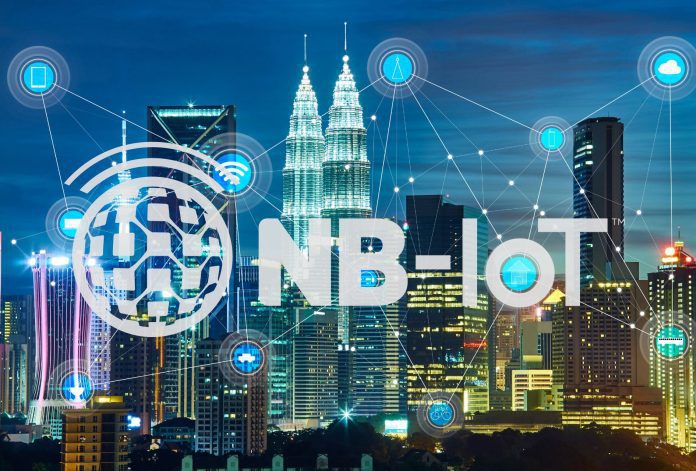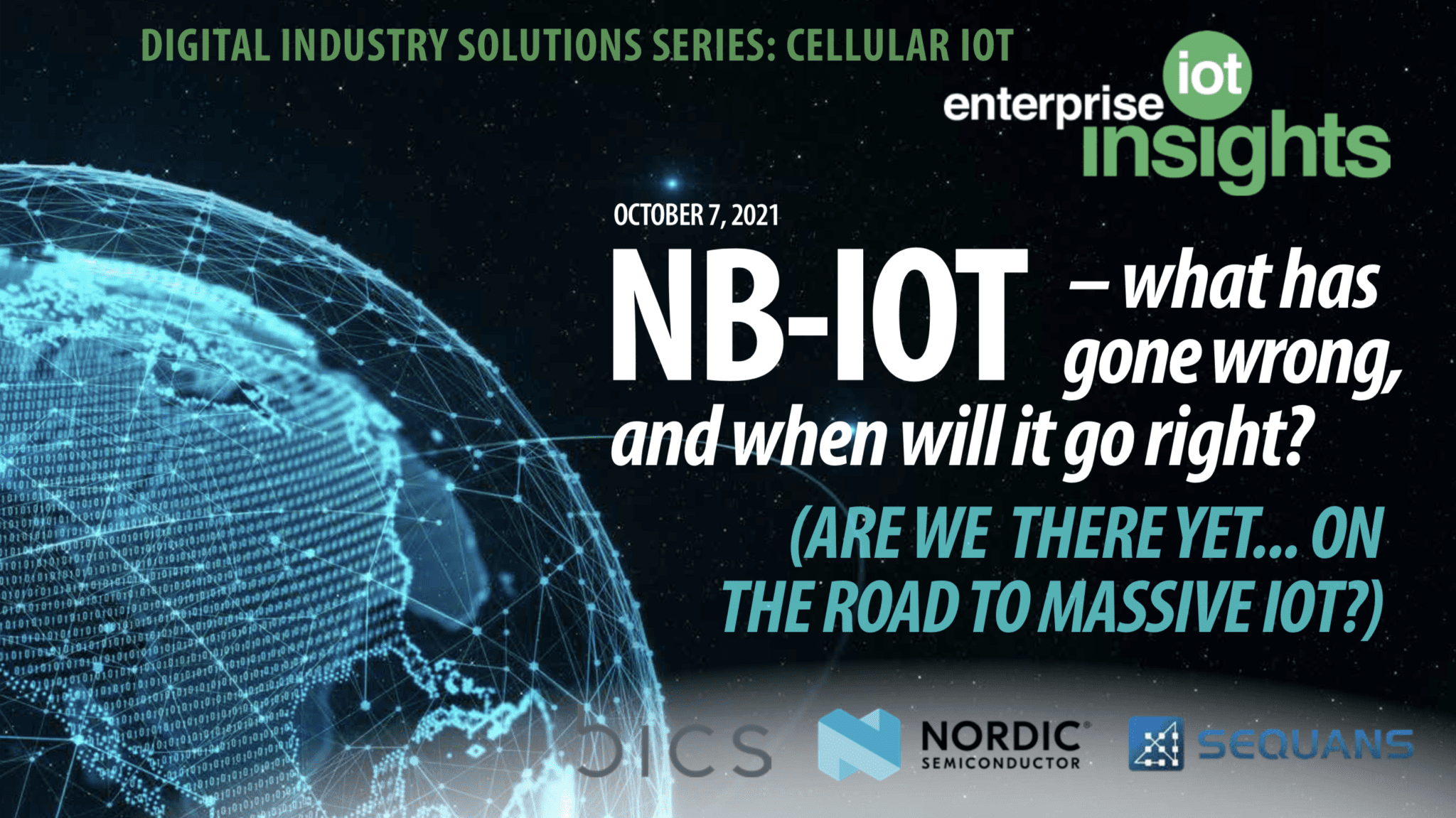Massive IoT? What a joke. Except no one in the business of massive IoT is laughing, because no one has given up on it. And because everyone is too busy trying to make it work. For the cellular industry, that means getting NB-IoT (and, to a lesser extent, LTE-M) to fly, at last – by finally untangling the mess around integration, interoperability, roaming, and billing that have made it the punchline in the comedy.
So, here are some quick thoughts on the state of the NB-IoT market (the state of ‘things’ for cellular), courtesy of France-based chip-maker Sequans, interviewed as part of research for a new Enterprise IoT Insights report and webinar on the same subject (subtitled, ‘what has gone wrong, and well will it go right?’). The report and webinar are scheduled for October 7; you can signup for the webinar here.
The problem with NB-IoT, says Sequans, is it has been over-hyped and undervalued by the operator community, which brought it to life five years ago to counter the perceived threat from non-cellular low-power wide-area (LPWA) equivalents, most notably LoRaWAN and Sigfox. Reports of its demise are greatly exaggerated, the market says, but there is no question its growth has been stunted, and its story has been hard to watch.
Speaking with Enterprise IoT Insights, Jeremy Gosteau, senior director of IoT product marketing at the firm, says NB-IoT was caught between a rock and a hard place, between the novelty of anything-goes 5G and the legacy of anywhere-goes 2G and 3G. More than this, NB-IoT was wrong-footed by LTE-M (Cat-M), its cellular-based sister-tech, developed by a different camp, but also geared for different ends.
He comments: “The problem is 5G came so quickly after Release 13 [of LTE-M and NB-IoT], so that operators deployed one or the other differently in each region – in North America, Europe, China. And all the marketing and technical rush to deploy 5G stopped some of the investment to bring LTE-M and NB-IoT to the right level of technical maturity. So it has taken time. But the technology is right, and the pricing is right – at least from a hardware perspective.”
We will come back to the pricing, of both hardware and airtime; but we should stick, for the moment, with the pincer movement that has forced NB-IoT into the telecoms shadows, and which has been appended and sharpened, effectively, by enforced competition with LTE-M alongside. “LTE-M [has complicated the picture], to some extent. Because these two ‘competing’ technologies came out at the same time – one pushed by China, the other by the western RAN vendors and operators.”
Gosteau goes on: “[Because they were pitched together], there was a huge overlap in terms of airtime costs, and not much distinction – even though they are different technologies, to serve different use cases. The market missed the opportunity to distinguish NB-IoT’s value. I mean, NB-IoT is a fundamentally different technology. It works in the guard band, which is free spectrum for operators – it is like the SMS of 2G, transmitting P2P information for free, with no impact on legacy LTE capacity.
“The operators could have come up with dedicated data plans for the guard bands. There is nearly no cost for them – they have to pay-for and monetise upgrades to their base stations, but that is pretty much it. They could have thought to distinguish between high-end LPWA LTE-M and low-end LPWA NB-IoT – for all kinds of LoRa-like apps, like trackers, building sensors, smoke detectors, garbage collectors, smart parking in cities, and so on.”
The subtext, here, which Sequans will not articulate in such terms, is the hardware companies have held up their end of the bargain, by forcing down NB-IoT (and LTE-M) module costs to around $5 for single-mode units, while the operator set, in its distraction and confusion, is putting LTE-M airtime costs, for a hot-blooded tech that barely makes the ‘low-power’ grade, against a lizard-like IoT standard, running a cold-blooded pulse in the LTE guard band for battery-powered sensors.
NB-IoT was supposed to be ‘the little train that could’; tickets are being sold like it is an inter-city locomotive. Has it been frustrating? “Yes,” responds Gosteau. “Because customers have come to us, asking to get the price for an NB-IoT module down to $2 or $3, to go into Europe, South America, Asia. But they want GPS, which is another buck, and connectivity, which is another $10 – it gets to the point where they ask why we’ve worked so hard to get the hardware costs down.”
He explains: “Because in the end, the hardware as a proportion of the total cost is not that significant. So, yes, it has been frustrating. But that is what it is, and it is also the role we play in the ecosystem anyway – educating the customers, to talk to the operators, to try to find a way to bundle the hardware and connectivity.” Invariably, the China story gets told; that 90 (or 85 or 95?) percent of the NB-IoT market is in China, while the rest of the world divides between NB-IoT and LTE-M, and gets nowhere.
It should be noted, as the new report will discuss, not everyone thinks the China model is the right model for rest-of-the-world NB-IoT. Enterprise deployments might be soaring, still, (despite the federal impetus shifting to 5G, away from NB-IoT), but no one is making any money; least of all hardware suppliers, which have seen their products commoditised and their profits eroded as local regulation has forced total conformity. Or so the story goes.
But Gosteau reflects: “China produced really good data plans, enough to motivate NB-IoT deployment nationally. That hasn’t been the case in other parts of the world. The thing about NB-IoT is the technology is good, and it could be great, already, if enterprises were able to pay 10 bucks all-in – for the hardware, connectivity, SIM – and just build it, deploy it, and forget about it, so it works for five or 10 years with no recurring costs. But that hasn’t been the case, so far; data plans are still too expensive.”
There are other aspects of the China story that will be explored in the report and webinar. And Gosteau’s view is not a downer, actually. NB-IoT is not dead, anymore than IoT is dead: it is just the market’s expectations of NB-IoT are conflated with its expectations of IoT, at large. And IoT is a hard nut to crack – or rather, it’s cracking has fragmented into so many pieces no one knows how to put it together again. As a cautionary tale about the distance between hype and reality, even in telecoms, it is hard to beat.
But the NB-IoT market has reasserted some kind of buoyancy. Roaming is being sorted, notes Gosteau; airtime pricing has improved across the board. He is optimistic, invariably, promoting a dual-band NB-IoT / LTE-M module strategy for Sequans to global markets. No, IoT is not about to get ‘massive’, yet, he says; it is a slow burn, rather than a pyrotechnic explosion, which will probably in the end grow out of a bonfire of telco vanities.
But the cellular-side of the low-power end of the IoT market is filled with opportunity. And, the message is, NB-IoT is finding its way out of the dark, as the miscast shadows of 5G and 2G/3G retreat, and its value gets clearer. “I see positive things for NB-IoT,” says Gosteau. “2G and 3G are ‘sunsetting’ in many countries and regions – even in Europe, in the next five to 10 years. And there is no other choice to address massive IoT applications. There is no NR provision for low-power IoT networks.”
He goes on: “All the 5G data rates today address eMBB and URLLC. For mMTC, it is all about extending LTE-M and NB-IoT. Release 17 and 18 introduce RedCap and e-RedCap for down-to-10 Mbps applications. But for the few-hundred kbps-types of apps, which is the target market for LTE-M and NB-IoT, there is no equivalent. So LTE-M and NB-IoT will continue and extend – and will do so also because of the non-promise of LoRaWAN and Sigfox.”
Ouch, on that last point. Actually, Gosteau is complementary about these rival non-cellular LPWA technologies, at least for private industrial and parochial national deployments. These points will be addressed, also, in the report. The final irony, to write here, is that the telecoms industry’s mistaken blurring of NB-IoT and LTE-M in the early days is being made real in the standardisation and development process.
Gosteau closes: “Where these technologies have been quite distinctive [and the opportunity has been missed to make that distinction], they also address some of the same use cases. And they become increasingly aligned in Release 14, with the introduction of Cat-NB2 NB-IoT with higher data rates. So in terms of the applications they can address, they are getting closer. So, where there was a clear distinction between them, it is narrowing all the time.”
What that means for national rollout of double-layer NB-IoT and LTE-M networks in each geography will be addressed, also, in the report. Check back on October 7; food for thought until then.


